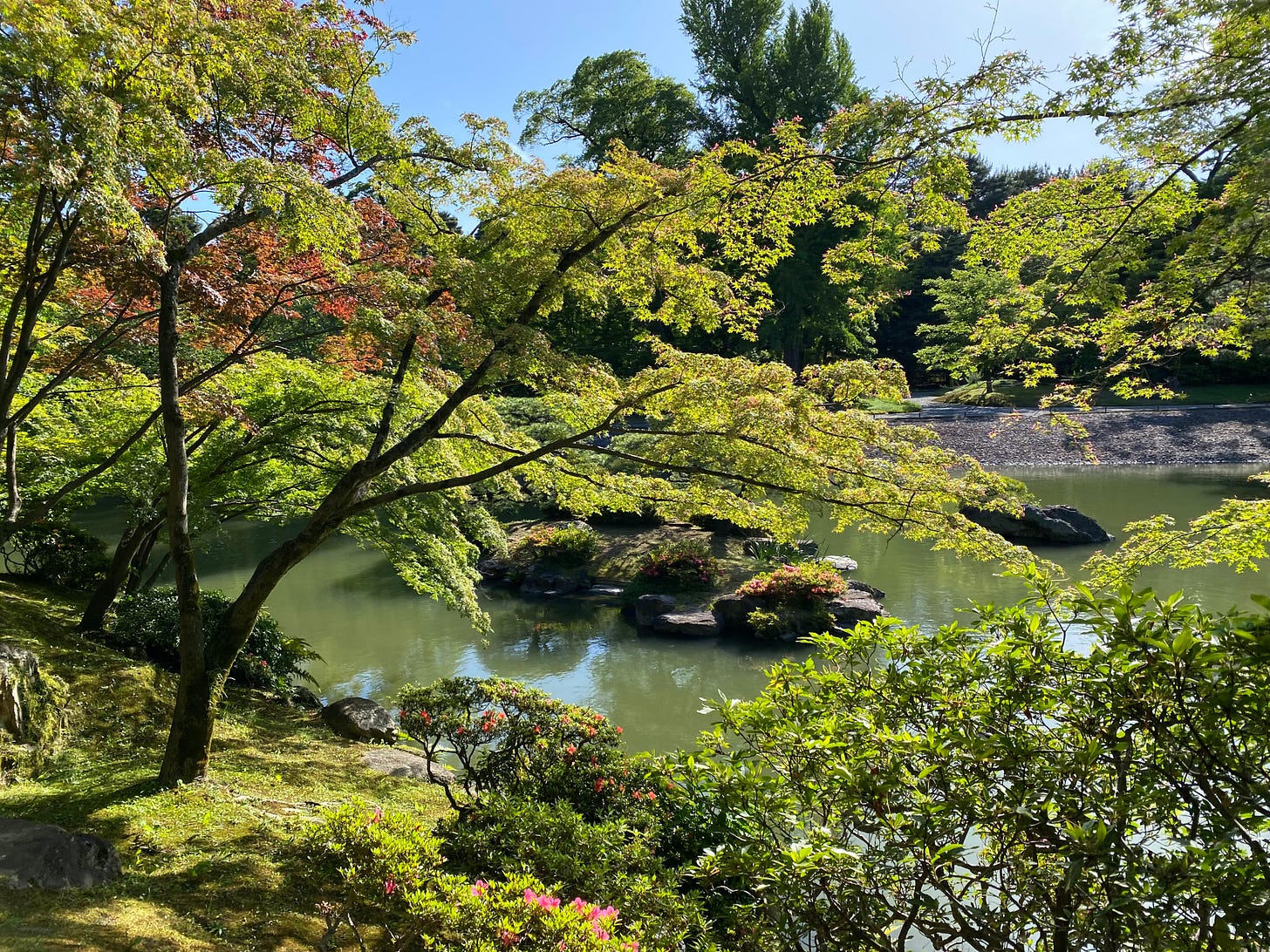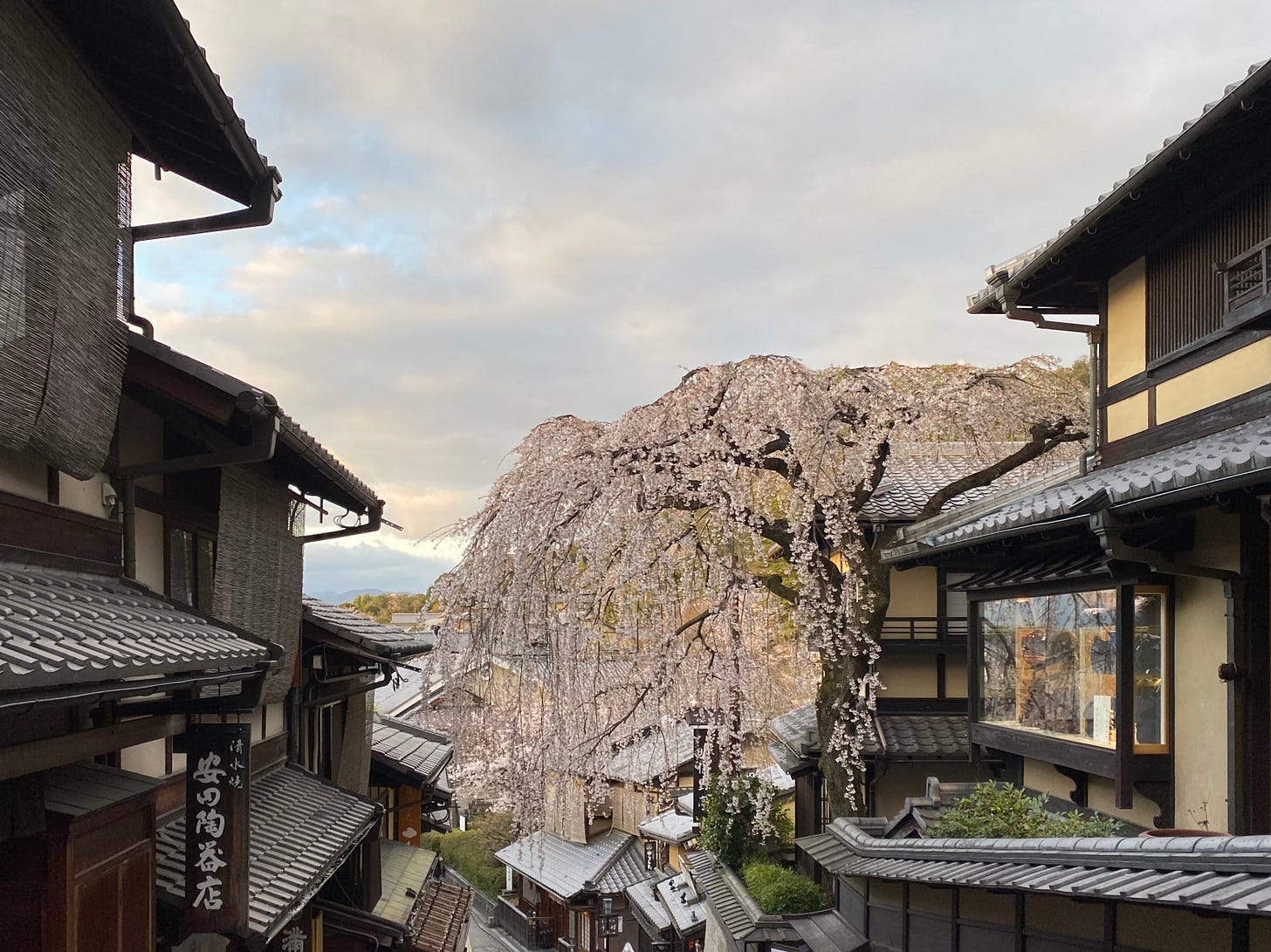How did fengshui plan Kyoto?
This is the first installation of my Cities posts. These will be anchored around a question that I find interesting and wish to investigate. Hope you enjoy!
The old Imperial Palace in Kyoto resembles a Russian doll from overhead—rectangles within rectangles within rectangles. Once in the very heart of the city, it now lies northeast of the modern city center, which lies closer to Kyoto Main Station.
My husband, who is Japanese, has visited Kyoto many times, and even took a summer course there during graduate school. We last visited the city together in 2023 during a trip to see our family. Having been before, we spent most of our time checking out craft shops and enjoying different neighborhoods, but (being the history nerd) I insisted that we at least visit the Imperial Palace. When we entered the complex, with its seemingly endless walking paths, towering gates, and plethora of cherry trees, he turned to me and said, “everything about this city follows fengshui.”
That gave me pause. I’d heard of fengshui before, having studied Chinese and lived in Taiwan. Originating in ancient China, fengshui (風水, lit. “wind [and] water”) is a process of arranging spaces to optimize the flow of qi (氣), an unseen energy that is thought to course through the universe and all living things.
But, what did that have to do with urban planning? I only knew of fengshui in the context of superstitious advice like, “don’t leave stuff strewn outside of your front door,” and “make sure to let air circulate through your home,” which, granted, are both good pieces of advice! Little did I know: fengshui had a much grander application.
Fengshui Principles in Urban Planning
Let’s say you’re in pre-modern China, Korea, or Japan and you’re planning to site a city. You find a pleasant valley and decide to start digging when a geomancer yanks away your shovel. “It’s clear you know nothing about designing cities,” he says, and points to his luopan compass (羅盤). “Allow me to explain.”
Mountains and Water
Cities need to back the mountains for protection and face rivers or lakes for wealth and prosperity. (靠山面水, in Chinese)
Gateways
Just like your front door, the main entrances to a city should facilitate the smooth circulation of qi by avoiding obstructions and sharp turns.
Cardinal Orientation
There’s a saying in Chinese: 坐北朝南 “Sit North [and] face South.” Buildings and streets should follow this advice, aligning along north-south axes to maximize sunlight and wind circulation.
Cosmic Alignment
Key buildings should rely on the Bagua (八卦) map to keep positive energy flow. Geomancers used luopan compasses for this purpose. (No, I currently can’t explain this process beyond that—it’s very confusing to this non-practitioner!)
Looking at your west-facing patch of grass, it’s clear to you now that you would’ve picked a terrible location for a city. “Geomancer, can you show me some examples of cities with good qi flow?” you plead.
The man looks very pleased with himself. “Naturally,” he says. “Right this way.”
Kyoto’s Fengshui-Based Design
Let’s revisit the city from the beginning of this post: Kyoto, Japan.
Kyoto’s founders explicitly designed the city based on Chinese fengshui principles. The city dates back to 794 AD, when the Japanese Imperial Court moved from Nara, and remained the capital of Japan until 1868. Planners modeled both Kyoto and Nara after the Sui Dynasty’s capital, Chang'an (長安), or modern-day Xi’an, China.1
Let’s start with Kyoto’s geography. Like most fengshui-based cities, Kyoto rests in a valley surrounded in its cardinal directions by mountains, water, and plains. This reflects the idea of the Four Guardians (四神) in Chinese mythology. To its north sits Mt. Hiei (比叡山), which acts as Kyoto’s protector. The Kamo River (賀茂川) flanks the city to its east, and the Katsura River (桂川) to its west—both Water Elements that bring auspicious qi. Kyoto faces open plains to its south that lead to Osaka (remember “Sit North and Face South?”). According to fengshui principles, this ensure an easy flow of wealth and trade—important features for a capital city.
The city’s planners didn’t stop with its natural geography. Kyoto’s street grid and buildings were also inspired by fengshui. To this day, the city follows a strict grid design aligned on north-south axes. There are slight bends in the street grid, though, that allow for controlled flow of qi, along with narrow alleyways that are thought to “store” good qi. While no longer visible in the city’s modern redevelopment, you can still see these alleyways in the historical districts like Gion.
In the city’s center rests the Imperial Palace, which was also modeled off Chinese city planning. This building was the centerpiece in a complex web of buildings meant to act as gateways for good qi and deflect harmful qi from the city and the Imperial Family. Examples include Kiyomizu-dera (清水寺) and Enryaku-ji (延暦寺), which sit at elevated positions above the city and ensure good flows of qi into the city.
Conclusion
Fengshui influenced nearly all of the fundamental decisions behind Kyoto’s siting and development. This is true not just for Kyoto, but for other historical cities in East Asia, such as Beijing, Nanjing, Seoul, and Hue. Even more modern cities, such as Taipei and Hong Kong demonstrate fengshui principles in their design; although, as mysticism is supplanted by more empirical philosophies that guide how we build our cities, these vestiges of the past become less pronounced.
Having learned these principles, I’ll pay closer attention the next time I make a trip to Kyoto.
George Sansom, A History of Japan to 1334, (Stanford: Stanford University Press, 1954), 100.






